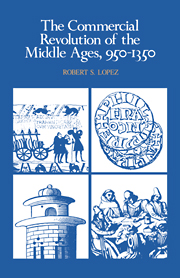Book contents
6 - THE RESPONSE OF THE AGRICULTURAL SOCIETY
Published online by Cambridge University Press: 03 December 2009
Summary
DYNAMISM AND INERTIA IN THE AGRICULTURAL WORLD
To close our survey of economic growth and commercialization we have to take another look at the world of cathedrals, castles, and country people. For all the expansion of trade and crafts, agriculture (with such related activities as herding and lumbering) continued throughout and beyond the Middle Ages to be the main occupation or source of income and power for the overwhelming majority of the European population.
This is hardly surprising: the shifting of the occupational balance from mainly agricultural to mainly nonagricultural is a very recent phenomenon. As late as the mid-nineteenth century, with the Industrial Revolution well on its way, no large nation in Europe except England had disengaged more than half of its population from agricultural pursuits, and if we lumped together the population of the whole world today we would, no doubt, find that agriculture still is the prevalent occupation or source of income and power. Any attempt at calculating proportions in the Middle Ages would produce no more than guesses, but certainly agriculture loomed still larger at that time, with the Commercial Revolution well advanced but industrialization barely sketched. Although independent merchant republics by the thirteenth century controlled nearly all of northern and central Italy, and more or less autonomous urban communities pockmarked all of the other regions, most of the European surface was still in the shade of agrarian monarchies and fiefs.
- Type
- Chapter
- Information
- The Commercial Revolution of the Middle Ages, 950–1350 , pp. 148 - 168Publisher: Cambridge University PressPrint publication year: 1976

